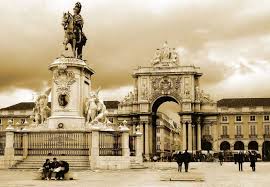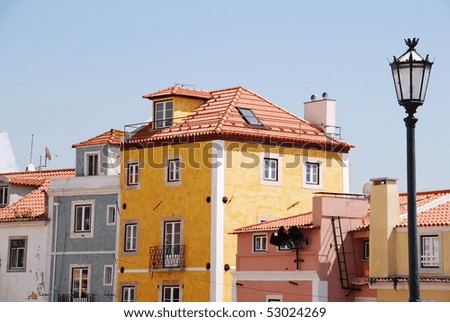Like so many children in India I grew up in Goa in the  shadow of the former British Empire. As a result London was a fabled city, the former centre of a truly global empire, and imagined to be filled with architectural marvels that should rightly grace an imperial centre.
shadow of the former British Empire. As a result London was a fabled city, the former centre of a truly global empire, and imagined to be filled with architectural marvels that should rightly grace an imperial centre.
Visiting London for the first time was a truly depressing let down however. There was practically nothing that was on a truly monumental, imperial scale. The experience on travelling to Lisbon on the other hand was an entirely different matter. Here indeed was a city that knew how to present itself as an imperial centre. Huge squares framed by monumental buildings. Façades of churches that, to borrow a phrase from James Fergusson, seemed to have been conceived by giants and finished by jewellers. And to top it all, as if to stick a tongue in the England’s gloomy direction, was the light.
 Lisbon’s name is said to be derived from the ancient name for the settlement Olissipo. This name in turn was associated with the mythical founding of the city by Ulysses, the Greek adventurer of the epics. The more boringly pedantic, will tell us that the name derives not from the Greek adventurer, but from the words that meant ‘safe harbour’. In time, Olissipo was transformed to its Arabic version Al-Isbuna, until when after the Crusader conquest it came to be called Lisboa. While there may be good reason to name the city for its safe harbour, it seems a travesty that Lisbon is not in fact called Luz Boa, and named for its good(Boa) light (luz).
Lisbon’s name is said to be derived from the ancient name for the settlement Olissipo. This name in turn was associated with the mythical founding of the city by Ulysses, the Greek adventurer of the epics. The more boringly pedantic, will tell us that the name derives not from the Greek adventurer, but from the words that meant ‘safe harbour’. In time, Olissipo was transformed to its Arabic version Al-Isbuna, until when after the Crusader conquest it came to be called Lisboa. While there may be good reason to name the city for its safe harbour, it seems a travesty that Lisbon is not in fact called Luz Boa, and named for its good(Boa) light (luz).
This city has the most  amazing light! It is a light that is sharp and sparkly and does the most amazing things to the city. The contribution of this light first dawned on me when traversing the city one morning early in my stay of the city. Moving from the cold shadows of the Rua do Loreto into the light in the Praça de Camões, one realised how privileged one was to live in this incredibly beautiful city of light. Whether it is out in the squares, or on jacaranda shaded avenues, the light that this city receives converts the golden yellow, salmon pink and powder blue façades of its buildings into so many Fabergé eggs. Polished by the scores of feet that daily caress the limestone cobbled streets of the city, in this light these sidewalks shine like so many silken ribbons nestling these exquisite precious eggs.
amazing light! It is a light that is sharp and sparkly and does the most amazing things to the city. The contribution of this light first dawned on me when traversing the city one morning early in my stay of the city. Moving from the cold shadows of the Rua do Loreto into the light in the Praça de Camões, one realised how privileged one was to live in this incredibly beautiful city of light. Whether it is out in the squares, or on jacaranda shaded avenues, the light that this city receives converts the golden yellow, salmon pink and powder blue façades of its buildings into so many Fabergé eggs. Polished by the scores of feet that daily caress the limestone cobbled streets of the city, in this light these sidewalks shine like so many silken ribbons nestling these exquisite precious eggs.
 And this light induces ecstasy. Standing on the edge of the Praça de Camões is the neo-classical façade of the church of the Incarnation (Igreja da Encarnação). Surmounting this façade are a series of dramatic ornamental urns sculpted to appear as if with flames at their mouths. Come sunshine and these urns catch the rays of the sun to incarnate variously as the burning bush of Sinai, or the icon for the Sacred Heart of Jesus. If light ever contributed to the drama of architecture this is a perfect example. The profound changes that this sight works on one’s sentiments can only be experienced every attempt at description falling short. It does drive home the point however to the perfection of Lisbon as a stage for this light. And it is thus that my heart confesses, ‘Lisboa, lux tua vita mihi’ (your light is my life)!
And this light induces ecstasy. Standing on the edge of the Praça de Camões is the neo-classical façade of the church of the Incarnation (Igreja da Encarnação). Surmounting this façade are a series of dramatic ornamental urns sculpted to appear as if with flames at their mouths. Come sunshine and these urns catch the rays of the sun to incarnate variously as the burning bush of Sinai, or the icon for the Sacred Heart of Jesus. If light ever contributed to the drama of architecture this is a perfect example. The profound changes that this sight works on one’s sentiments can only be experienced every attempt at description falling short. It does drive home the point however to the perfection of Lisbon as a stage for this light. And it is thus that my heart confesses, ‘Lisboa, lux tua vita mihi’ (your light is my life)!
(First published in the Herald 5 March 2011)
 amazing light! It is a light that is sharp and sparkly and does the most amazing things to the city. The contribution of this light first dawned on me when traversing the city one morning early in my stay of the city. Moving from the cold shadows of the Rua do Loreto into the light in the Praça de Camões, one realised how privileged one was to live in this incredibly beautiful city of light. Whether it is out in the squares, or on jacaranda shaded avenues, the light that this city receives converts the golden yellow, salmon pink and powder blue façades of its buildings into so many Fabergé eggs. Polished by the scores of feet that daily caress the limestone cobbled streets of the city, in this light these sidewalks shine like so many silken ribbons nestling these exquisite precious eggs.
amazing light! It is a light that is sharp and sparkly and does the most amazing things to the city. The contribution of this light first dawned on me when traversing the city one morning early in my stay of the city. Moving from the cold shadows of the Rua do Loreto into the light in the Praça de Camões, one realised how privileged one was to live in this incredibly beautiful city of light. Whether it is out in the squares, or on jacaranda shaded avenues, the light that this city receives converts the golden yellow, salmon pink and powder blue façades of its buildings into so many Fabergé eggs. Polished by the scores of feet that daily caress the limestone cobbled streets of the city, in this light these sidewalks shine like so many silken ribbons nestling these exquisite precious eggs. And this light induces ecstasy. Standing on the edge of the Praça de Camões is the neo-classical façade of the church of the Incarnation (Igreja da Encarnação). Surmounting this façade are a series of dramatic ornamental urns sculpted to appear as if with flames at their mouths. Come sunshine and these urns catch the rays of the sun to incarnate variously as the burning bush of Sinai, or the icon for the Sacred Heart of Jesus. If light ever contributed to the drama of architecture this is a perfect example. The profound changes that this sight works on one’s sentiments can only be experienced every attempt at description falling short. It does drive home the point however to the perfection of

No comments:
Post a Comment